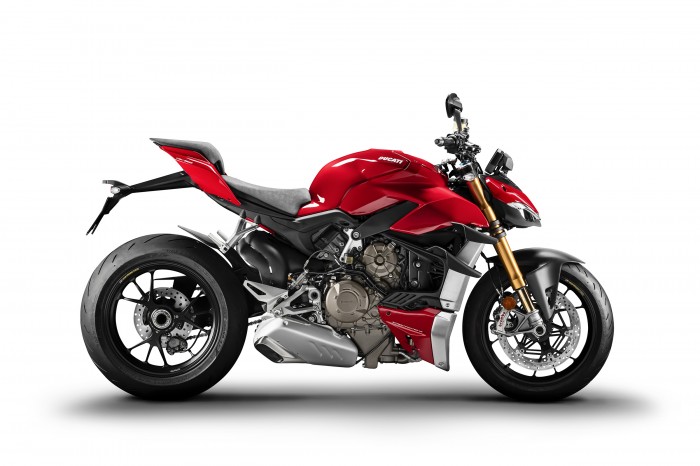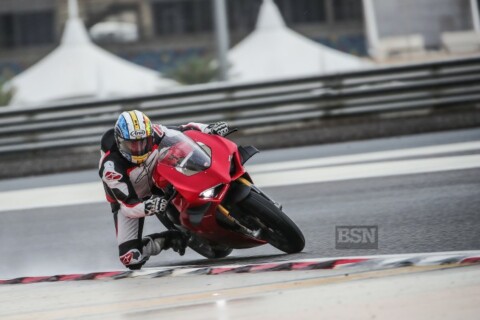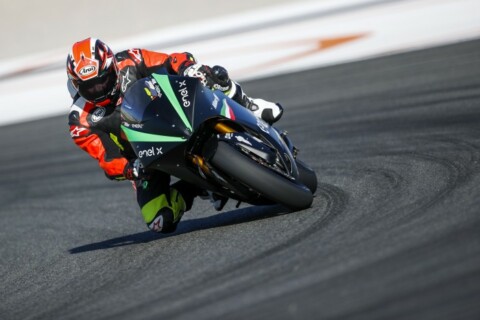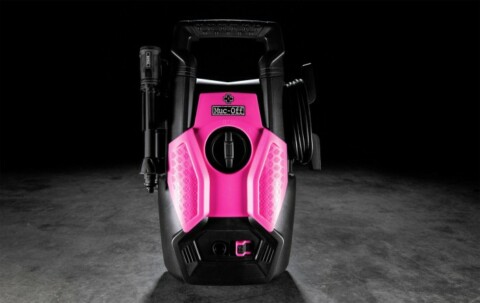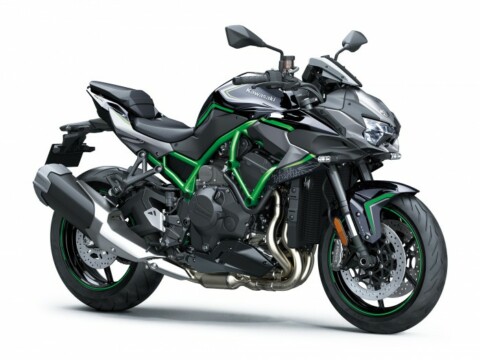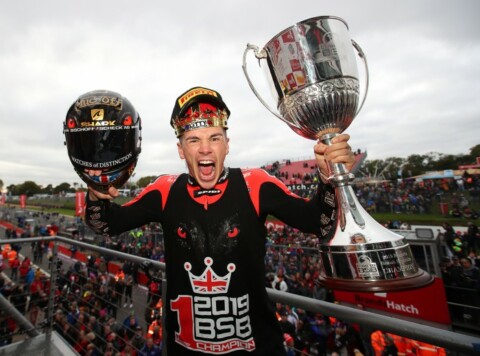Just hours after Kawasaki unwrapped its supercharged Z H2 hypernaked, Ducati has unveiled a 200bhp V4-powered Streetfighter.
Basically, it is a Panigale V4 stripped of its bodywork with wide bars added and was inspired, say Ducati bosses by The Joker.
Engine
The new Streetfighter V4 is powered by a 1103cc Desmosedici Stradale engine. In this configuration the 90° V4 delivers 208bhp@12,750 rpm, an unrivalled power level within the naked segment, perfectly in keeping with the all-out character of the new Streetfighter V4.
Maximum torque is 123Nm@11,500 rpm, practically unchanged with respect to the Panigale V4. Dedicated engine mapping lets riders safely make the most of Streetfighter V4 performance on the road.
The final ratio, shorter than that of the Panigale V4, delivers a wheel torque higher of +10%, which ensures an immediate response to the throttle command.
The engine can be boosted to 220bhp with an Akrapovic exhaust, which also reduces weight by 6kg to 172.
Chassis
The Streetfighter V4 features the Front-Frame - an offshoot of Ducati’s extensive experience in MotoGP - which uses the Desmosedici Stradale engine as a load-bearing member.
Compared to traditional perimeter frames the main lay-out difference is that the engine is used as a structural chassis element. Weighing just 4 kg, the compact Front-Frame is attached directly to the upper crankcase of the front cylinder bank and the cylinder head of the rear bank; the V4 crankcase also provides the rear suspension attachment point and the single-sided swingarm pivot mount.
The key advantage of the Ducati Front-Frame is that it uses the Desmosedici Stradale engine to achieve the desired stiffness: this has resulted in significantly lower main frame length and weight and a better stiffness/weight ratio. Moreover, the struts alongside the engine have been shortened, making bike design more compact, especially in the rider’s seat area.
Completing the chassis is the under-seat Trellis subframe, attached to the Front-Frame at the top and bolted to the head of the rear cylinder bank below.
The rear suspension linkage mechanism is attached to the Desmosedici Stradale engine via a forged aluminium bracket. The linkage reacts to movements imparted by a cast aluminium high-truss swingarm. Steering geometry features a 24.5° rake and 100 mm trail.
And it’s got wings…
Ducati says: “Fast, agile road performance demands maximum stability at high speed and when braking, reduced wheelie during acceleration and minimised electronic control of the suspension set-up: that’s why Ducati Corse specialists have, together with the Ducati Style Centre, developed biplane wings for the Streetfighter V4.
“The aerodynamics were developed using CFD (Computational Fluid Dynamics) simulation. The calculation method involved stationary simulation of flow and pressure to achieve increased downforce, especially on the front wheel.
“To reduce lateral protrusion as much as possible, the aerodynamics team decided to adopt a ‘biplane’ configuration of limited ‘wingspan’ with upper and lower wings working independently. Each appendage can be described as a square-plan mono-wing with a winglet on its outer tip. Moreover, the wings have been positioned as close as possible to the front wheel (near the radiator side panels) to maximise the anti-wheelie effect.
“These aerodynamic appendages generate 28 kg of downforce at 270 kph (20 kg on the front wheel, 8 kg on the rear). The wings also help draw heat off the engine by increasing water and oil radiator throughflow speeds by 2% and 10% respectively.
“Wing-generated downforce attenuates front wheel ‘floating’ at high speed and the tendency to wheel-up. It also improves stability during braking at the turn-in point and through the corner.
“The aerodynamics thus instil confidence and limit intervention by electronic controls. This helps the rider keep the throttle open longer and brake later going into the bends, providing significant performance benefits.”
At a glance:
- 1103 cm3 Desmosedici Stradale engine
- Front frame
- 16-litre aluminium tank with under-seat extension
- Fully adjustable 43 mm Showa Big Piston Fork (BPF)
- Fully adjustable Sachs monoshock
- Sachs steering damper
- Braking system with Brembo Stylema® monobloc calipers
- Pirelli Diablo Rosso Corsa II tyres (rear 200/60)
- ‘Biplane’ wing configuration
- Latest-generation electronics package with 6-axis Inertial Measurement Unit (6D IMU): ABS Cornering EVO; Ducati Traction Control (DTC) EVO 2; Ducati Slide Control (DSC); Ducati Wheelie Control (DWC) EVO; Ducati Power Launch (DPL); Ducati Quick Shift up/down (DQS) EVO 2; Engine Brake Control (EBC) EVO
- Keys for fast level changes
- Full-TFT 5” screen
- Riding Modes (Race, Sport, Street)
- Full-LED headlight with DRL
- Two-seater configuration
- Ready for Ducati Data Analyser+ GPS (DDA+ GPS) and Ducati Multimedia System (DMS)

